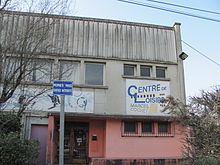Saint-Maurice-de-Beynost plant
Construction of the plant in the late 1920s, followed by actual production, led to a large influx of workers to Saint-Maurice-de-Beynost; the population quintupled in five years, from around 300 in 1926 to over 1,500 in 1931.
[1] Maurice Cusin was looking for a site in the Lyon region to establish the second factory of the Société lyonnaise de soie artificielle (SLSA), after the one in Décines created in 1922.
[3][4] There was some local reluctance (for fear of nuisance from industrial activity), but despite this, Maurice Cusin bought 50 hectares in Les Brotteaux, between the Miribel canal and the Lyon-Geneva railway line.
[6] In 1930, workers of mainly Armenian and Polish origin left SLSA's first plant (in Décines) to work in Saint-Maurice-de-Beynost.
A new activity was decided for the site, which resumed in 1960 : the production of Terphane, the trade name of polyethylene terephthalate, i.e. saturated polyester.
1967 was also marked by a major strike lasting three weeks from 15 March:[14][15] the two main demands were for a performance bonus and a hoped-for increase in the basic wage.
[16] From 16 March onwards, picket lines were set up at every entrance to the plant, leading to the occupation of the factory, which was no longer accessible.
On 17 March, elected representatives – notably the Ain deputy Émile Dubuis and his successor Guy de La Verpillière in the 3rd constituency from April 1967 – offered to mediate.
[17] From 19 March onwards, the strikers organized themselves and received help from the town hall, which distributed vouchers to families; the HLM office was also contacted to ask for the rent payment date to be postponed.
[17] Until 23 March, meetings were held between the Ain prefect Georges Dupoizat de Villemont, the labor inspector, the mayor of Saint-Maurice-de-Beynost André Trichard and (successively) the CGT and CFDT elected representatives, then the plant management.
At 10 p.m., the meeting was suspended and a visit was made to the picket line, where the men were becoming increasingly nervous; the delegates had to reason with them to avoid blunders.
[18] – Michel Branciard, La CFDT dans l'Ain, évolution depuis 1920Finally, an agreement was reached after midnight:[17] it still had to be submitted to the strikers' general meeting organized the following day, on 6 April.
[19] The text (including wage increases, improvements to the performance bonus and a number of points relating to social works) was approved at the end of the AGM.
[21] This reduction in the number of employees led to strikes, sometimes lasting several days, as in February 2002, due to the understaffing observed by the unions.
[22] The raw material for production is cellulose, generally sourced from Northern Europe and delivered to the factory in sheet form.
The oil crisis and competition from polypropylene led to a slowdown in activity, despite the filing of a number of patents obtained as a result of research carried out at the plant (e.g. Composite polyester films and process for producing the same in 1975).
[20] In 2022, Axens and Toray Films Europe launch a study for a chemical recycling plant for polyethylene terephthalate at the Saint-Maurice-de-Beynost site.
[30] Indeed, on 23 November 1929, the municipal council, concerned about the arrival of a new population in the commune, approved the creation of a fixed gendarmerie post, which would eventually be located on Avenue des Îles.
As the Saint-Maurice church could only hold around a hundred people, a wooden chapel was quickly built in 1930 to accommodate the workers.
[32] The installation of this chapel was apparently favored by Maurice Cusin: the geographical concentration of housing, the place of worship and all ancillary activities around the factory, corresponded to his paternalistic vision.










